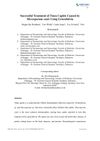Gray Patch Tinea Capitis by Microsporum Canis in a Child: A Case Report Highlighting Environmental Risk Factors and Diagnostic Nuances
August 2025
in “
Bioscientia Medicina Journal of Biomedicine and Translational Research
”

TLDR Environmental factors like shared combs can spread tinea capitis, and trichoscopy helps diagnose it.
This case report describes a 3-year-old girl with gray patch tinea capitis caused by Microsporum canis, highlighting environmental risk factors such as salon exposure and shared combs in transmission. Despite no direct animal contact, fomite transmission was suggested. Diagnostic challenges were addressed using trichoscopy, which detected fungal infection despite a negative Wood's lamp examination. The child fully recovered after a 6-week treatment with oral griseofulvin and topical ketoconazole, with visible hair regrowth. The report emphasizes the importance of considering environmental reservoirs in managing tinea capitis and the utility of trichoscopy in diagnosis, advocating for a forensic approach to clinical history and targeted interventions to reduce transmission.
